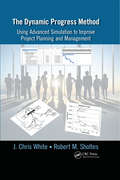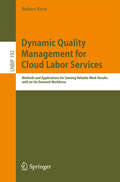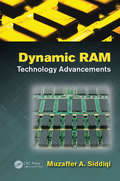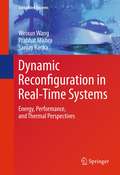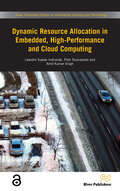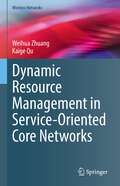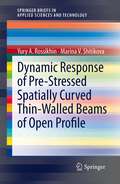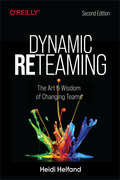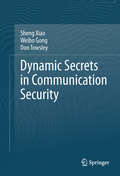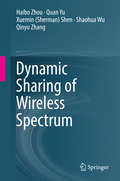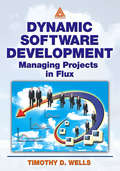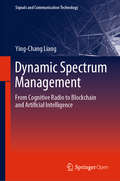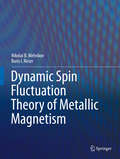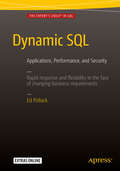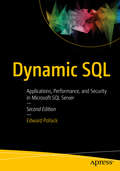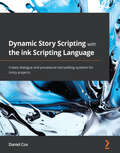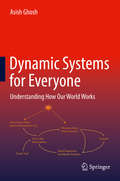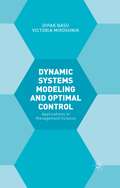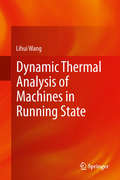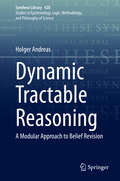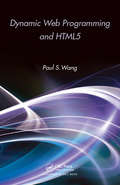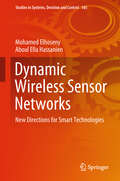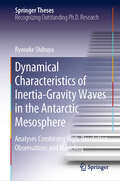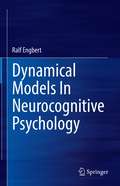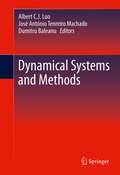- Table View
- List View
The Dynamic Progress Method: Using Advanced Simulation to Improve Project Planning and Management
by J. Chris White Robert M. SholtesRecent computer-based tools for project planning and management focus on user-friendliness and interconnectivity. However, these programs function on the Critical Path Method, or CPM, which was created in the 1950s. These programs, which involve simplistic models and methods, ignore the fact that the underlying computations on which they function h
Dynamic Quality Management for Cloud Labor Services
by Robert KernHow can a scalable and efficient quality management mechanism for cloud labor services be designed in a way that it delivers results with a well-defined level of quality to the requester? Cloud labor services are a specific form of crowdsourcing: A coordination platform serves as an interface between requesters who need to get work done and a large crowd of workers who want to perform work. An early example of such a platform is Amazon's Web marketplace Mturk, on which service requesters can publish open calls for so-called human intelligence tasks (HITs). Robert Kern's work makes a considerable contribution toward solving the quality problem for scalable human work. On the basis of a comprehensive framework of cloud labor, he develops a set of methods to conceptually measure and aggregate the quality of human work results, implements a platform to put those methods to work, and evaluates their application in a number of very compelling, real-world scenarios successfully combining concepts from statistics, information technology, and management. Reading this book will be beneficial to novices in cloud labor services looking for orientation in this new field as well as to advanced researchers and practitioners developing cloud quality concepts.
Dynamic RAM: Technology Advancements
by Muzaffer A. SiddiqiBecause of their widespread use in mainframes, PCs, and mobile audio and video devices, DRAMs are being manufactured in ever increasing volume, both in stand-alone and in embedded form as part of a system on chip. Due to the optimum design of their components—access transistor, storage capacitor, and peripherals—DRAMs are the cheapest and densest semiconductor memory currently available. As a result, most of DRAM structure research and development focuses on the technology used for its constituent components and their interconnections. However, only a few books are available on semiconductor memories in general and fewer on DRAMs. Dynamic RAM: Technology Advancements provides a holistic view of the DRAM technology with a systematic description of the advancements in the field since the 1970s, and an analysis of future challenges. Topics Include: DRAM cells of all types, including planar, three-dimensional (3-D) trench or stacked, COB or CUB, vertical, and mechanically robust cells using advanced transistors and storage capacitors Advancements in transistor technology for the RCAT, SCAT, FinFET, BT FinFET, Saddle and advanced recess type, and storage capacitor realizations How sub 100 nm trench DRAM technologies and sub 50 nm stacked DRAM technologies and related topics may lead to new research Various types of leakages and power consumption reduction methods in active and sleep mode Various types of SAs and yield enhancement techniques employing ECC and redundancy A worthwhile addition to semiconductor memory research, academicians and researchers interested in the design and optimization of high-density and cost-efficient DRAMs may also find it useful as part of a graduate-level course.
Dynamic Reconfiguration in Real-Time Systems
by Prabhat Mishra Weixun Wang Sanjay RankaGiven the widespread use of real-time multitasking systems, there are tremendous optimization opportunities if reconfigurable computing can be effectively incorporated while maintaining performance and other design constraints of typical applications. The focus of this book is to describe the dynamic reconfiguration techniques that can be safely used in real-time systems. This book provides comprehensive approaches by considering synergistic effects of computation, communication as well as storage together to significantly improve overall performance, power, energy and temperature.
Dynamic Resource Allocation in Embedded, High-Performance and Cloud Computing (River Publishers Series In Information Science And Technology Ser.)
by Leandro Soares Indrusiak Piotr Dziurzanski Amit Kumar SinghThe availability of many-core computing platforms enables a wide variety of technical solutions for systems across the embedded, high-performance and cloud computing domains. However, large scale manycore systems are notoriously hard to optimise. Choices regarding resource allocation alone can account for wide variability in timeliness and energy dissipation (up to several orders of magnitude). Dynamic Resource Allocation in Embedded, High-Performance and Cloud Computing covers dynamic resource allocation heuristics for manycore systems, aiming to provide appropriate guarantees on performance and energy efficiency. It addresses different types of systems, aiming to harmonise the approaches to dynamic allocation across the complete spectrum between systems with little flexibility and strict real-time guarantees all the way to highly dynamic systems with soft performance requirements. Technical topics presented in the book include: • Load and Resource Models• Admission Control• Feedback-based Allocation and Optimisation• Search-based Allocation Heuristics• Distributed Allocation based on Swarm Intelligence• Value-Based AllocationEach of the topics is illustrated with examples based on realistic computational platforms such as Network-on-Chip manycore processors, grids and private cloud environments.
Dynamic Resource Management in Service-Oriented Core Networks (Wireless Networks)
by Weihua Zhuang Kaige QuThis book provides a timely and comprehensive study of dynamic resource management for network slicing in service-oriented fifth-generation (5G) and beyond core networks. This includes the perspective of developing efficient computation resource provisioning and scheduling solutions to guarantee consistent service performance in terms of end-to-end (E2E) data delivery delay. Network slicing is enabled by the software defined networking (SDN) and network function virtualization (NFV) paradigms. For a network slice with a target traffic load, the E2E service delivery is enabled by virtual network function (VNF) placement and traffic routing with static resource allocations. When data traffic enters the network, the traffic load is dynamic and can deviate from the target value, potentially leading to QoS performance degradation and network congestion. Data traffic has dynamics in different time granularities. For example, the traffic statistics (e.g., mean and variance) can be non-stationary and experience significant changes in a coarse time granularity, which are usually predictable. Within a long time duration with stationary traffic statistics, there are traffic dynamics in small timescales, which are usually highly bursty and unpredictable. To provide continuous QoS performance guarantee and ensure efficient and fair operation of the network slices over time, it is essential to develop dynamic resource management schemes for the embedded services in the presence of traffic dynamics during virtual network operation. Queueing theory is used in system modeling, and different techniques including optimization and machine learning are applied to solving the dynamic resource management problems.Based on a simplified M/M/1 queueing model with Poisson traffic arrivals, an optimization model for flow migration is presented to accommodate the large-timescale changes in the average traffic rates with average E2E delay guarantee, while addressing a trade-off between load balancing and flow migration overhead. To overcome the limitations of Poisson traffic model, the authors present a machine learning approach for dynamic VNF resource scaling and migration. The new solution captures the inherent traffic patterns in a real-world traffic trace with non-stationary traffic statistics in large timescale, predicts resource demands for VNF resource scaling, and triggers adaptive VNF migration decision making, to achieve load balancing, migration cost reduction, and resource overloading penalty suppression in the long run. Both supervised and unsupervised machine learning tools are investigated for dynamic resource management. To accommodate the traffic dynamics in small time granularities, the authors present a dynamic VNF scheduling scheme to coordinate the scheduling among VNFs of multiple services, which achieves network utility maximization with delay guarantee for each service. Researchers and graduate students working in the areas of electrical engineering, computing engineering and computer science will find this book useful as a reference or secondary text. Professionals in industry seeking solutions to dynamic resource management for 5G and beyond networks will also want to purchase this book.
Dynamic Response of Pre-Stressed Spatially Curved Thin-Walled Beams of Open Profile
by Marina Shitikova Yury A. RossikhinThis short book analyses the dynamic stability with respect to small perturbations, as well as the local damage of geometrically nonlinear elastic, spatially curved, open section beams with axial precompression. Transient waves, which are the surfaces of strong discontinuity and wherein the stress and strain fields experience discontinuities, are used as small perturbations; in so doing the discontinuities are considered to be of small magnitude. Such waves are initiated during low-velocity impacts upon thin-walled beams. The theory of discontinuities and the method of ray expansions which allow one to find the desired fields behind the fronts of the transient waves in terms of discontinuities in time-derivatives of the values to be found, are used as the methods of solution for short-time dynamic processes. The example of using the ray expansions for analyzing the impact response of spatially curved thin-walled beams of open profile is demonstrated by solving the problem about the normal impact of an elastic hemispherical-nosed rod upon an elastic arch representing itself a channel-beam curved along an arc of the circumference. The influence of the initial stresses on the dynamic fields has been investigated.
Dynamic Reteaming: The Art and Wisdom of Changing Teams
by Heidi HelfandYour team will change whether you like it or not. People will come and go. Your company might double in size or even be acquired. In this practical book, author Heidi Helfand shares techniques for reteaming effectively. Engineering leaders will learn how to catalyze team change to reduce the risk of attrition, learning and career stagnation, and the development of knowledge silos.Based on research into well-known software companies, the patterns in this book help CTOs and team managers effectively integrate new hires into an existing team, manage a team that has lost members, or deal with unexpected change. You’ll learn how to isolate teams for focused innovation, rotate team members for knowledge sharing, break through organizational apathy, and more. <P><P>You’ll explore: <P><P>Real-world examples that demonstrate why and how organizations reteam <P><P>Five reteaming patterns: One by One, Grow and Split, Isolation, Merging, and Switching <P><P>Tactics to help you master dynamic reteaming in your company <P><P>Stories that demonstrate problems caused by reteaming anti-patterns
Dynamic Secrets in Communication Security
by Don Towsley Sheng Xiao Weibo GongDynamic secrets are constantly generated and updated from messages exchanged between two communication users. When dynamic secrets are used as a complement to existing secure communication systems, a stolen key or password can be quickly and automatically reverted to its secret status without disrupting communication. "Dynamic Secrets in Communication Security" presents unique security properties and application studies for this technology. Password theft and key theft no longer pose serious security threats when parties frequently use dynamic secrets. This book also illustrates that a dynamic secret based security scheme guarantees impersonation attacks are detected even if an adversary steals a user's password or their key is lost. Practitioners and researchers working in network security or wireless communications will find this book a must-have reference. "Dynamic Secrets in Communication Security" is also a valuable secondary text for advanced-level students in computer science and electrical engineering.
Dynamic Sharing of Wireless Spectrum
by Haibo Zhou Quan Yu Xuemin Sherman Shen Shaohua Wu Qinyu ZhangThis book focuses on the current research on the dynamic spectrum sharing for efficient spectrum resource utilization, which covers the overlay spectrum sharing, underlay spectrum sharing and database-assisted spectrum sharing related research issues. Followed by a comprehensive review and in-depth discussion of the current state-of-the-art research literature and industry standardization, this book first presents a novel overlay spectrum sharing framework for dynamic utilization of available cellular frequency bands, formulates the dynamic spectrum sharing problem as a dynamic resource demand-supply matching problem, and accordingly develops a distributed fast spectrum sharing algorithm to solve the resource matching problem. A self-awareness power control approach for multi-hop routing selection is proposed, which can establish an effective and practical routing selection optimization in secondary access networks and minimize the interference to primary users. Finally, this book offers dynamic secondary access scheme for database-assisted spectrum sharing networks, which is targeted to support the prosperous wireless multimedia networking applications by leveraging the TV white spaces of geolocation databases while satisfying QoS guarantees of secondary users. The overlay spectrum sharing, underlay spectrum sharing, and database-assisted white spaces spectrum sharing research results that are presented in this book provide useful insights for the design of next generation wireless access networks. This book motivates a new line of thinking for efficient spectrum resource utilization and performance enhancements of future wireless access applications.
Dynamic Software Development: Managing Projects in Flux
by Timothy WellsThe ever changing nature of information makes the job of managing software development notoriously difficult. Dynamic Software Development: Managing Projects in Flux eases the burden by defining the principles, practices, skills, and techniques needed to manage a dynamic development environment. At a hands-on level, the text helps managers define t
Dynamic Spectrum Management: From Cognitive Radio to Blockchain and Artificial Intelligence (Signals and Communication Technology)
by Ying-Chang LiangThis open access book, authored by a world-leading researcher in this field, describes fundamentals of dynamic spectrum management, provides a systematic overview on the enabling technologies covering cognitive radio, blockchain, and artificial intelligence, and offers valuable guidance for designing advanced wireless communications systems. This book is intended for a broad range of readers, including students and professionals in this field, as well as radio spectrum policy makers.
Dynamic Spin-Fluctuation Theory of Metallic Magnetism
by Nikolai B. Melnikov Boris I. ReserThis book presents a theoretical framework for magnetism in ferromagnetic metals and alloys at finite temperatures. The objective of the book is twofold. First, it gives a detailed presentation of the dynamic spin-fluctuation theory that takes into account both local and long-wave spin fluctuations with any frequency. The authors provide a detailed explanation of the fundamental role of quantum spin fluctuations in the mechanism of metallic magnetism and illustrate the theory with concrete examples. The second objective of the book is to give an accurate and self-contained presentation of many-body techniques such as the functional integral method and Green's functions, via a number of worked examples. These computational methods are of great use to solid state physicists working in a range of specialties.The book is intended primarily for researchers, but can also be used as textbook. The introductory chapters offer clear and complete derivations of the fundamentals, which makes the presentation self-contained. The main text is followed by a number of well-organized appendices that contain a detailed presentation of the necessary many-body techniques and computational methods. The book also includes a list of symbols and detailed index. This volume will be of interest to a wide range of physicists interested in magnetism and solid state physics in general, both theoreticians and experimentalists.
Dynamic SQL
by Edward PollackThis book is an introduction and deep-dive into the many uses of dynamic SQL in Microsoft SQL Server. Dynamic SQL is key to large-scale searching based upon user-entered criteria. It's also useful in generating value-lists, in dynamic pivoting of data for business intelligence reporting, and for customizing database objects and querying their structure. Executing dynamic SQL is at the heart of applications such as business intelligence dashboards that need to be fluid and respond instantly to changing user needs as those users explore their data and view the results. Yet dynamic SQL is feared by many due to concerns over SQL injection attacks. Reading Dynamic SQL: Applications, Performance, and Security is your opportunity to learn and master an often misunderstood feature, including security and SQL injection. All aspects of security relevant to dynamic SQL are discussed in this book. You will learn many ways to save time and develop code more efficiently, and you will practice directly with security scenarios that threaten companies around the world every day. Dynamic SQL: Applications, Performance, and Security helps you bring the productivity and user-satisfaction of flexible and responsive applications to your organization safely and securely. Your organization's increased ability to respond to rapidly changing business scenarios will build competitive advantage in an increasingly crowded and competitive global marketplace. Discusses many applications of dynamic SQL, both simple and complex. Explains each example with demos that can be run at home and on your laptop. Helps you to identify when dynamic SQL can offer superior performance. Pays attention to security and best practices to ensure safety of your data. What you'll learn Build flexible applications that respond fast to changing business needs. Take advantage of unconventional but productive uses of dynamic SQL. Protect your data from attack through best-practices in your implementations. Know about SQL Injection and be confident in your defenses against it Run at high performance by optimizing dynamic SQL in your applications. Troubleshoot and debug dynamic SQL to ensure correct results. Who this book is for Dynamic SQL: Applications, Performance, and Security is for developers and database administrators looking to hone and build their T-SQL coding skills. The book is ideal for advanced users wanting to plumb the depths of application flexibility and troubleshoot performance issues involving dynamic SQL. The book is also ideal for beginners wanting to learn what dynamic SQL is about and how it can help them deliver competitive advantage to their organizations.
Dynamic SQL: Applications, Performance, and Security in Microsoft SQL Server
by Edward PollackTake a deep dive into the many uses of dynamic SQL in Microsoft SQL Server. This edition has been updated to use the newest features in SQL Server 2016 and SQL Server 2017 as well as incorporating the changing landscape of analytics and database administration. Code examples have been updated with new system objects and functions to improve efficiency and maintainability.Executing dynamic SQL is key to large-scale searching based on user-entered criteria. Dynamic SQL can generate lists of values and even code with minimal impact on performance. Dynamic SQL enables dynamic pivoting of data for business intelligence solutions as well as customizing of database objects. Yet dynamic SQL is feared by many due to concerns over SQL injection or code maintainability. Dynamic SQL: Applications, Performance, and Security in Microsoft SQL Server helps you bring the productivity and user-satisfaction of flexible and responsive applications to your organization safely and securely. Your organization’s increased ability to respond to rapidly changing business scenarios will build competitive advantage in an increasingly crowded and competitive global marketplace. With a focus on new applications and modern database architecture, this edition illustrates that dynamic SQL continues to evolve and be a valuable tool for administration, performance optimization, and analytics.What You'ill LearnBuild flexible applications that respond to changing business needsTake advantage of creative, innovative, and productive uses of dynamic SQLKnow about SQL injection and be confident in your defenses against itAddress performance concerns in stored procedures and dynamic SQLTroubleshoot and debug dynamic SQL to ensure correct resultsAutomate your administration of features within SQL ServerWho This Book is For Developers and database administrators looking to hone and build their T-SQL coding skills. The book is ideal for developers wanting to plumb the depths of application flexibility and troubleshoot performance issues involving dynamic SQL. The book is also ideal for programmers wanting to learn what dynamic SQL is about and how it can help them deliver competitive advantage to their organizations.
Dynamic Story Scripting with the ink Scripting Language: Create dialogue and procedural storytelling systems for Unity projects
by Daniel CoxBring your stories to life by combining the narrative scripting language, ink, with a plugin to build dialogue, quest, and procedural storytelling systems for Unity projectsKey FeaturesLearn how to translate stories into ink code to create interactive projectsGain valuable insight into the ink story API to create engaging stories using the Unity pluginDevelop drop-in solutions to common narrative problems for Unity projectsBook Descriptionink is a narrative scripting language designed for use with game engines such as Unity through a plugin that provides an application programming interface (API) to help you to move between the branches of a story and access the values within it. Hands-On Dynamic Story Scripting with the ink Scripting Language begins by showing you how ink understands stories and how to write some simple branching projects. You'll then move on to advanced usage with looping structures, discovering how to use variables to set up dynamic events in a story and defining simple rules to create complex narratives for use with larger Unity projects. As you advance, you'll learn how the Unity plugin allows access to a running story through its API and explore the ways in which this can be used to move data in and out of an ink story to adapt to different interactions and forms of user input. You'll also work with three specific use cases of ink with Unity by writing a dialogue system and creating quest structures and other branching narrative patterns. Finally, this will help you to find out how ink can be used to generate procedural storytelling patterns for Unity projects using different forms of data input. By the end of this book, you will be able to move from a simple story to an intricate Unity project using ink to power complex narrative structures.What you will learnDiscover how ink understands stories and their partsExamine ink patterns for making branching narrativesDevelop code in Unity using the ink plugin to manipulate storiesDesign advanced projects combining ink stories with C# codeCompare common use cases for ink and Unity, such as dialogue systemsDetermine how ink can best fit into future narrative projectsWho this book is forThis book is for Unity developers looking for a solution for narrative-driven projects and authors who want to create interactive story projects in Unity. Basic knowledge of Unity game engine development and related concepts is needed to get the most out of this book.
Dynamic Systems for Everyone: Understanding How Our World Works
by Asish GhoshSystems are everywhere and we are surrounded by them. We are a complex amalgam of systems that enable us to interact with an endless array of external systems in our daily lives. They are electrical, mechanical, social, biological, and many other types that control our environment and our well-being. By appreciating how these systems function, will broaden our understanding of how our world works. Readers from a variety of disciplines will benefit from the knowledge of system behavior they will gain from this book and will be able to apply those principles in various contexts. The treatment of the subject is non-mathematical, and the book considers some of the latest concepts in the systems discipline, such as agent based systems, optimization, and discrete events and procedures. The diverse range of examples provided in this book, will allow readers to:Apply system knowledge at work and in daily life without deep mathematical knowledge;Build models and simulate system behaviors on a personal computer; Optimize systems in many different ways;Reduce or eliminate unintended consequences;Develop a holistic world view .This book will enable readers to not only better interact with the systems in their professional and daily lives, but also allow them to develop and evaluate them for their effectiveness in achieving their designed purpose.Comments from Reviewers: “This is a marvelously well written introduction to Systems Thinking and System Dynamics - I like it because it introduces Systems Thinking with meaningful examples, which everyone should be able to readily connect” - Gene Bellinger, Organizational theorist, systems thinker, and consultant, Director Systems Thinking World “Excellent book ...very well written. Mr. Ghosh's world view of system thinking is truly unique” - Peter A. Rizzi, Professor Emeritus, University of Massachusetts Dartmouth “A thorough reading of the book provides an interesting way to view many problems in our society” –Bradford T. Stokes, Poppleton Chair and Professor Emeritus, The Ohio State University College of Medicine “This is a very good and very readable book that is a must read for any person involved in systems theory in any way - which may actually include just about everyone” - Peter G. Martin, Vice President Business Value Consulting, Schneider Electric
Dynamic Systems Modelling and Optimal Control: Applications in Management Science
by Victoria Miroshnik Dipak BasuDynamic Systems Modelling and Optimal Control explores the applications of oil field development, energy system modelling, resource modelling, time varying control of dynamic system of national economy, and investment planning.
Dynamic Thermal Analysis of Machines in Running State
by Lihui WangWith the increasing complexity and dynamism in today's machine design and development, more precise, robust and practical approaches and systems are needed to support machine design. Existing design methods treat the targeted machine as stationery. Analysis and simulation are mostly performed at the component level. Although there are some computer-aided engineering tools capable of motion analysis and vibration simulation etc., the machine itself is in the dry-run state. For effective machine design, understanding its thermal behaviours is crucial in achieving the desired performance in real situation. Dynamic Thermal Analysis of Machines in Running State presents a set of innovative solutions to dynamic thermal analysis of machines when they are put under actual working conditions. The objective is to better understand the thermal behaviours of a machine in real situation while at the design stage. The book has two major sections, with the first section presenting a broad-based review of the key areas of research in dynamic thermal analysis and simulation, and the second section presents an in-depth treatment of relevant methodology and algorithms, leading to better understanding of a machine in real situation. The book is a collection of novel ideas, taking into account the need for presenting intellectual challenges while appealing to a broad readership, including academic researchers, practicing engineers and managers, and graduate students. Given the essential role of modern machines in factory automation and quality assurance, a book dedicated to the topic of dynamic thermal analysis, and its practical applications to machine design would be beneficial to readers of all design and manufacturing sectors, from machine design to automotive engineering, in better understanding the present challenges and solutions, as well as future research directions in this important area.
Dynamic Tractable Reasoning: A Modular Approach to Belief Revision (Synthese Library #420)
by Holger AndreasThis book aims to lay bare the logical foundations of tractable reasoning. It draws on Marvin Minsky's seminal work on frames, which has been highly influential in computer science and, to a lesser extent, in cognitive science. Only very few people have explored ideas about frames in logic, which is why the investigation in this book breaks new ground. The apparent intractability of dynamic, inferential reasoning is an unsolved problem in both cognitive science and logic-oriented artificial intelligence. By means of a logical investigation of frames and frame concepts, Andreas devises a novel logic of tractable reasoning, called frame logic. Moreover, he devises a novel belief revision scheme, which is tractable for frame logic. These tractability results shed new light on our logical and cognitive means to carry out dynamic, inferential reasoning. Modularity remains central for tractability, and so the author sets forth a logical variant of the massive modularity hypothesis in cognitive science.This book conducts a sustained and detailed examination of the structure of tractable and intelligible reasoning in cognitive science and artificial intelligence. Working from the perspective of formal epistemology and cognitive science, Andreas uses structuralist notions from Bourbaki and Sneed to provide new foundational analyses of frames, object-oriented programming, belief revision, and truth maintenance. Andreas then builds on these analyses to construct a novel logic of tractable reasoning he calls frame logic, together with a novel belief revision scheme that is tractable for frame logic. Put together, these logical analyses and tractability results provide new understandings of dynamic and inferential reasoning.Jon Doyle, North Carolina State University
Dynamic Web Programming and HTML5
by Paul S. WangWith organizations and individuals increasingly dependent on the Web, the need for competent, well-trained Web developers and maintainers is growing. Helping readers master Web development, Dynamic Web Programming and HTML5 covers specific Web programming languages, APIs, and coding techniques and provides an in-depth understanding of the underlyin
Dynamic Wireless Sensor Networks: New Directions For Smart Technologies (Studies in Systems, Decision and Control #165)
by Aboul Ella Hassanien Mohamed ElhosenyThis book provides a collection of high-quality research works that address broad challenges in both theoretical and applied aspects of dynamic wireless sensor networks (WSNs) for intelligent and smart applications in a variety of environments. It presents the most central concepts associated with Dynamic Wireless Sensor Networks applications, and discusses issues surrounding Wireless Sensor Network Structures for complex and mobile-based applications. The book subsequently discusses several topics related to energy management in dynamic WSNs, and reviews the steps involved in building a secure and trusted data transmission model using the WSN applications of intelligent environments. Lastly, it discusses the applications of WSNs in live data systems such as SCADA systems. Readers will discover a collection of high-quality research works that address broad challenges in both theoretical and applied aspects of WSNs for intelligent real-life applications. In addition, the book presents original research on the application of a dynamic WSN to solve the problem of energy consumption in a secure WSN during the process of data aggregation and transmission. Written by respected experts in the field, the book will stimulate further efforts in the application of the intelligent WSNs model, helping to solve the problem of data processing in a limited resource WSN-based environment.
Dynamical Characteristics of Inertia-Gravity Waves in the Antarctic Mesosphere: Analyses Combining High-Resolution Observations and Modeling (Springer Theses)
by Ryosuke ShibuyaThis book examines the origins and dynamical characteristics of atmospheric inertia-gravity waves in the Antarctic mesosphere. Gravity waves are relatively small-scale atmospheric waves with a restoring force of buoyancy that can transport momentum upward from the troposphere to the middle atmosphere. In previous studies, the dynamical characteristics of mesospheric gravity waves have not been fully examined using numerical simulations, since performing a numerical simulation with a high resolution and a high model-top requires considerable computational power. However, recent advances in computational capabilities have allowed us to perform numerical simulations using atmospheric general circulation models, which cover the troposphere to the mesosphere with a sufficiently fine horizontal resolution to resolve small-scale gravity waves. The book first describes the simulation of mesospheric gravity waves using a high-resolution non-hydrostatic atmospheric model with a high model top. The accuracy of the numerical results was confirmed by the first Mesosphere-Stratosphere-Troposphere/Incoherent Scattering (MST/IS) radar observation in the Antarctic. It also depicts the origins and propagation processes of mesospheric gravity waves on the basis of the results of the high-resolution numerical model. The behaviors of mesospheric gravity waves can be clearly explained using both fundamental and cutting-edge theories of fluid dynamics
Dynamical Models In Neurocognitive Psychology
by Ralf EngbertThe development of cognitive models is a key step in the challenging research program to advance our understanding of human cognition and behavior. Dynamical models represent a general and flexible approach to cognitive modeling. This introduction focuses on applications of stochastic processes and dynamical systems to model cognition. The dynamical approach is particularly useful to emphasize the strong link between experimental research (and its paradigms), data analysis, and mathematical models including their computer implementation for numerical simulation. Most of specific examples are from the domain of eye movement research, with concepts being applicable to a broad range of problems in cognitive modeling. The textbook aims at the graduate and/or advanced undergraduate level for students in Cognitive Science and related disciplines such as Psychology and Computer Science. Joint introduction of the theory of cognitive processes and mathematical models, their underlying mathematical concepts, numerical simulation, and analysis;The focus on eye movements provide a theoretically coherent, but very general application area;Computer code in R Programming Language for Statistical Computing is available for all examples, figures, and solutions to exercises.
Dynamical Systems and Methods
by Dumitru Baleanu Albert C. Luo José António MachadoNonlinear Systems and Methods For Mechanical, Electrical and Biosystems presents topics observed at the 3rd Conference on Nonlinear Science and Complexity(NSC), focusing on energy transfer and synchronization in hybrid nonlinear systems. The studies focus on fundamental theories and principles,analytical and symbolic approaches, computational techniques in nonlinear physical science and mathematics. Broken into three parts, the text covers: Parametrical excited pendulum, nonlinear dynamics in hybrid systems, dynamical system synchronization and (N+1) body dynamics as well as new views different from the existing results in nonlinear dynamics, mathematical methods for dynamical systems including conservation laws, dynamical symmetry in nonlinear differential equations and invex energies and nonlinear phenomena in physical problems such as solutions, complex flows, chemical kinetics, Toda lattices and parallel manipulator. This book is useful to scholars, researchers and advanced technical members of industrial laboratory facilities developing new tools and products.
